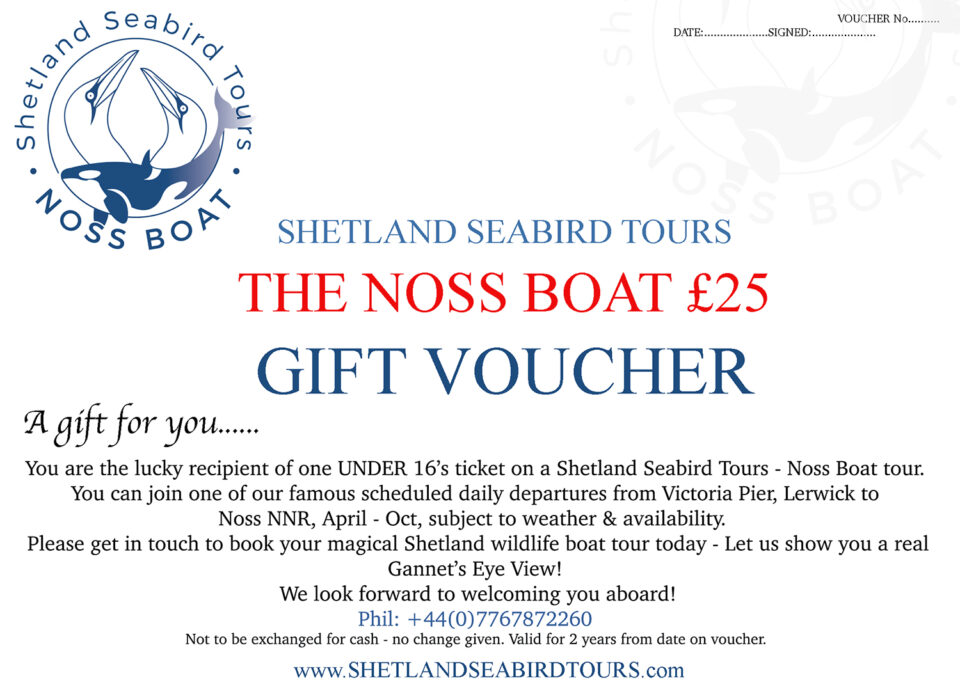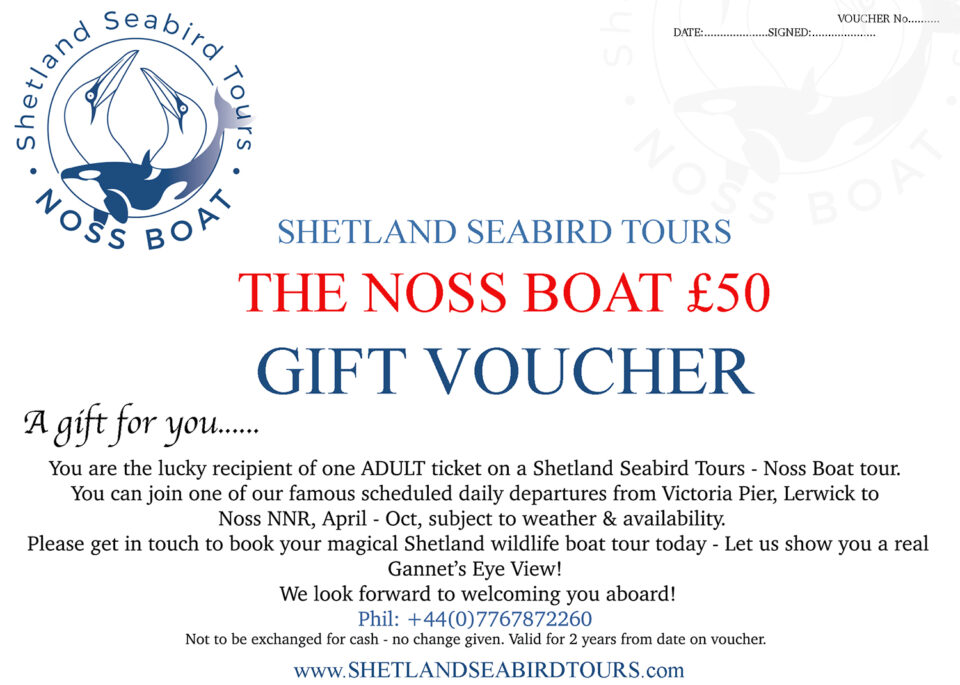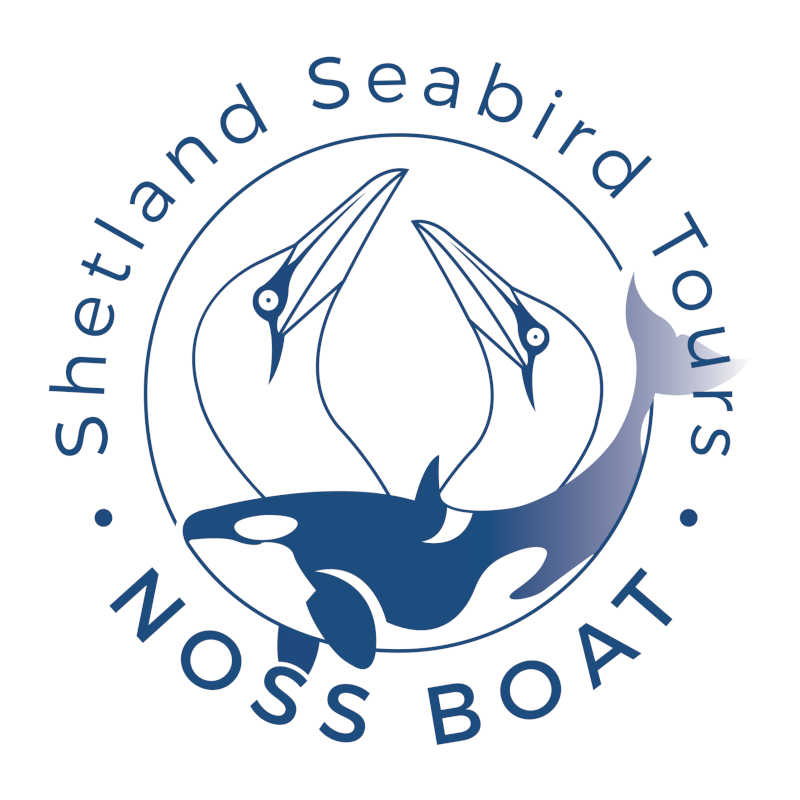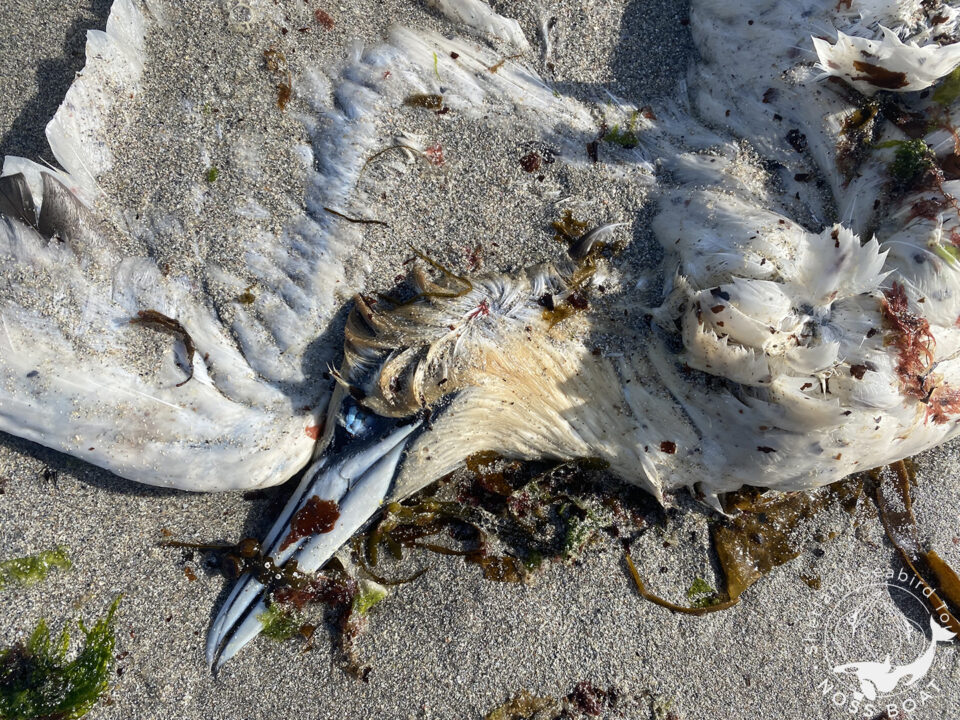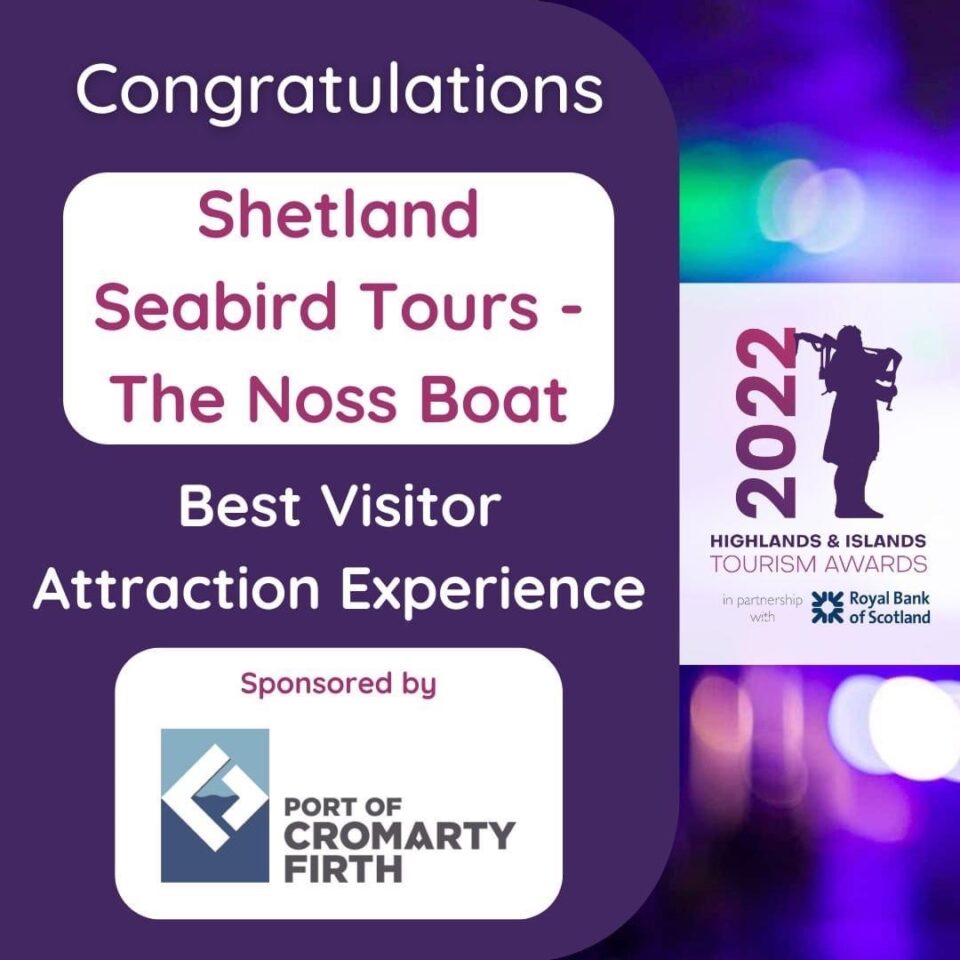
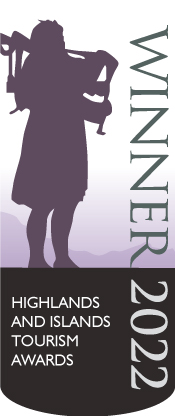
Passengers and staff were treated to the most spectacular marine mammal encounter imaginable on Saturday mornings Noss Boat tour when en-route to Noss, Shetland Seabird Tours bespoke wildlife boat found themselves surrounded on all sides by a fabulous group of over 70 White-beaked Dolphins, playing in the surf, riding the bow of the boat, and on occasion, leaping and breaching right out of the water in Noss Sound.
“It was an unforgettable experience, having never seen such a large, playful, showy group of Dolphin, you just didn’t know where to look or where to point the camera next!” SST Passenger
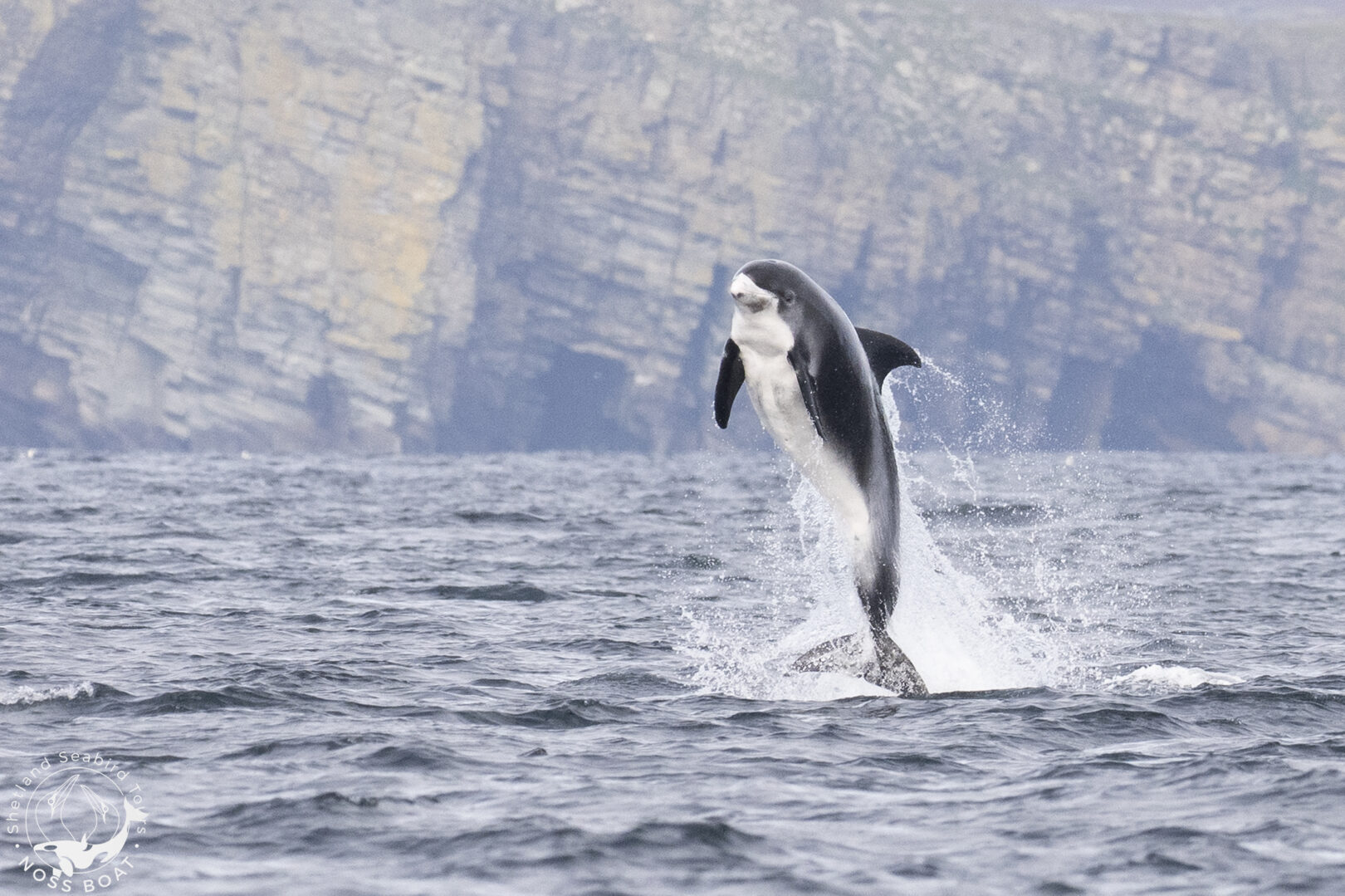
After making sure delighted passengers, including the owners 7 year old daughter Ayda were getting super views & photo opportunities, Rebecca, who is a professional bird photographer & new OM SYSTEM Ambassador, took a series of shots of one mid-distance, boisterous animal which was surfacing regularly as if on a pogo stick!
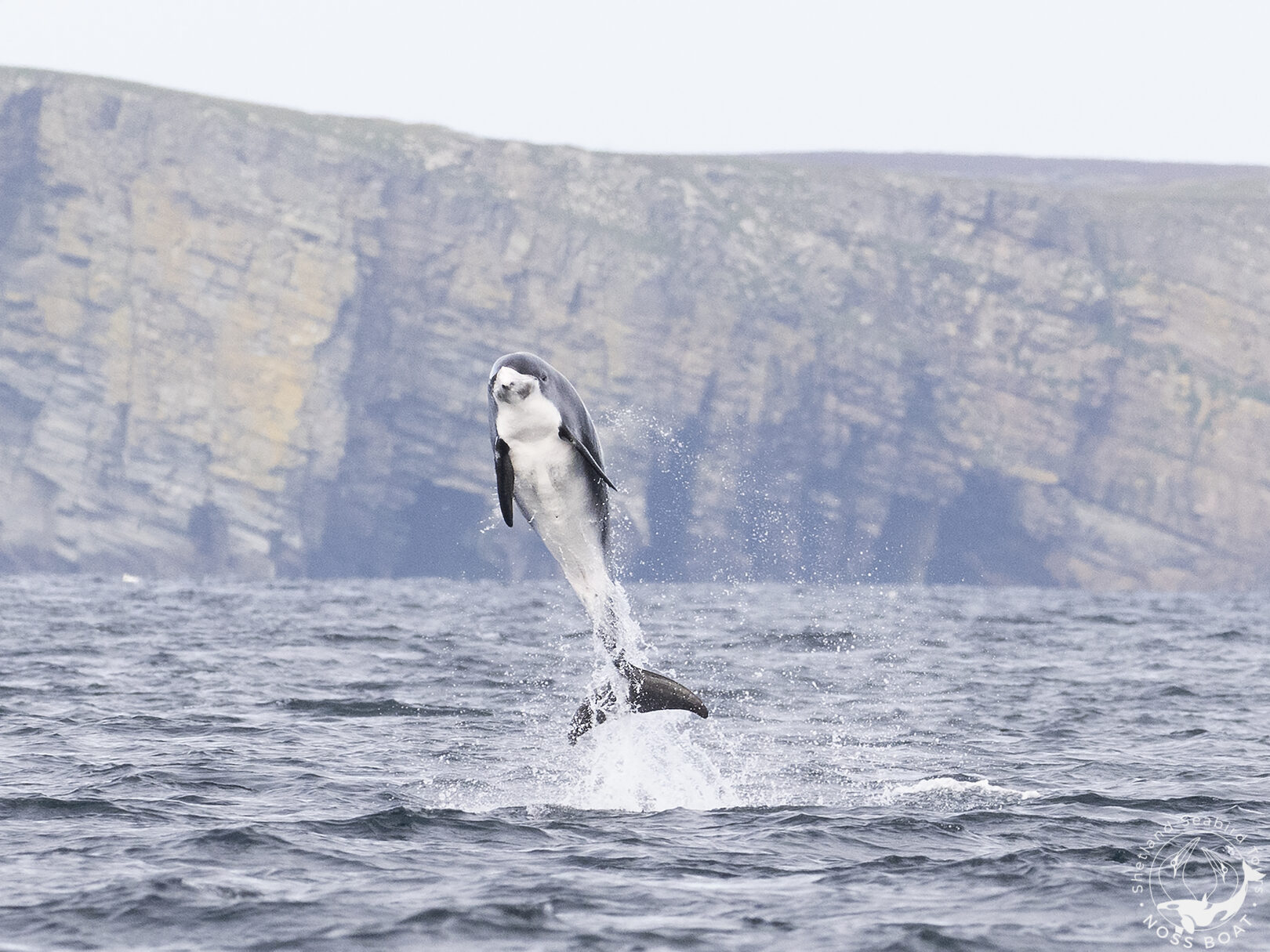
She says ” I had taken numerous shots of dolphins as they surfaced in small groups all over the place, but find it a lot harder photographing cetaceans than birds and was struggling to connect with such brief surface encounters, which are all to often gone just after they are seen with no time to raise the camera, fully engage & press the shutter! I noticed a few animals leaping right out of the water a little further away and decided to concentrate on these as they were visible for a few seconds longer out of the water whilst fully breaching. I could hardly believe my eyes when I looked at the back of the camera & realised that I had caught this stunningly beautiful marine mammal in full breach & that it was sharp! These images were only possible due to the awesome mirrorless OM SYSTEM gear I converted to during lockdown, the autofocus is just super fast, so I didn’t miss the moment!
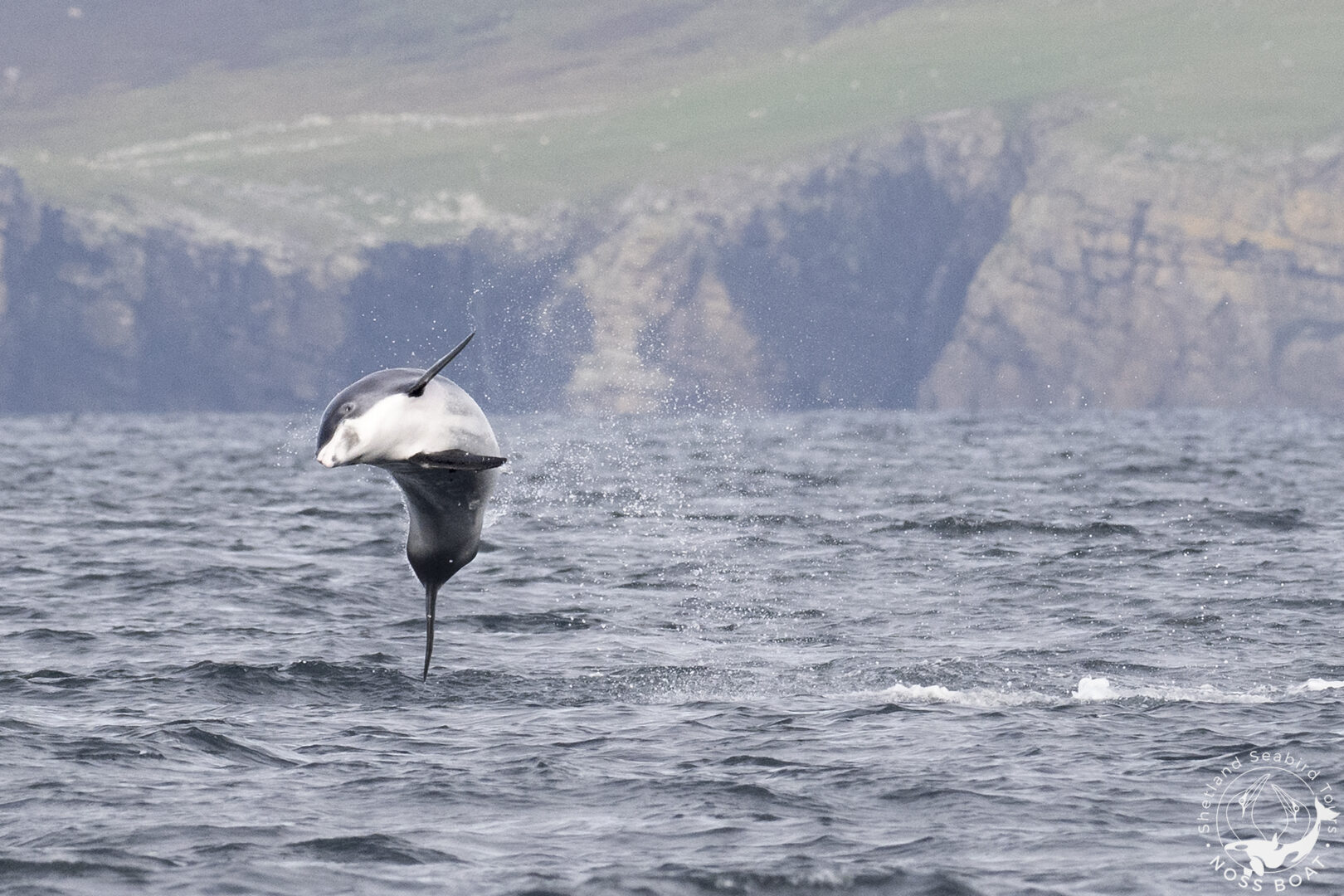
Cetaceans are being observed from Shetland Seabird Tours – The Noss Boat with increasing regularity, and this year has been exceptional with numerous sightings including the biggest ever counts we’ve had of Minke Whale, Basking Shark & Rissos Dolphin, also magical Orca encounters & daily Harbour Porpoise observations. All this on top of the dramatic wildlife spectacles surrounding the seabird city of Noss, with it’s awe-inspiring cliffs heaving with birdlife, and over 25,000 northern gannets in full breeding mode, surely one of Europe’s finest wildlife encounters by boat.
Owners, Rebecca & Phil are still buzzing from their weekend boat experience, with tours soon winding down for another season. “It has been our best year to date in both numbers of passengers & wildlife encounters, & we are fired up to see what the 2023 season brings. We have several varied contracts now into late autumn including working with the National Oceanography Centre survey team’s Boaty McBoatface project off Bressay. And as finalists in this year’s coveted Highlands & Islands Tourism Awards, in the Best Visitor Attraction Experience” category, we are looking forward to joining the other Shetland category finalists for the awards ceremony in November in Inverness before we get back to finishing some new business developments in 2023″. Rebecca & Phil
All images taken using OM SYSTEM:
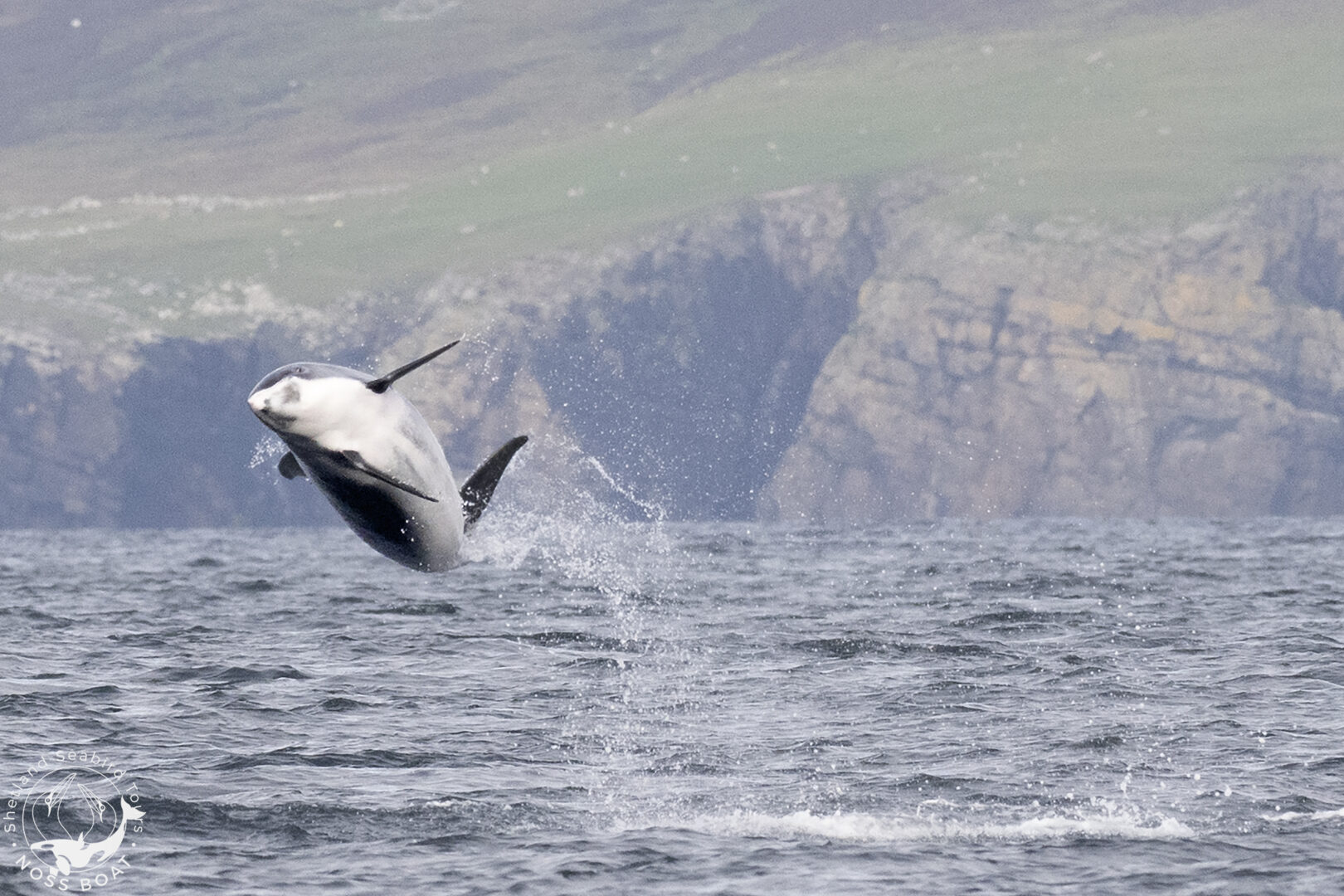
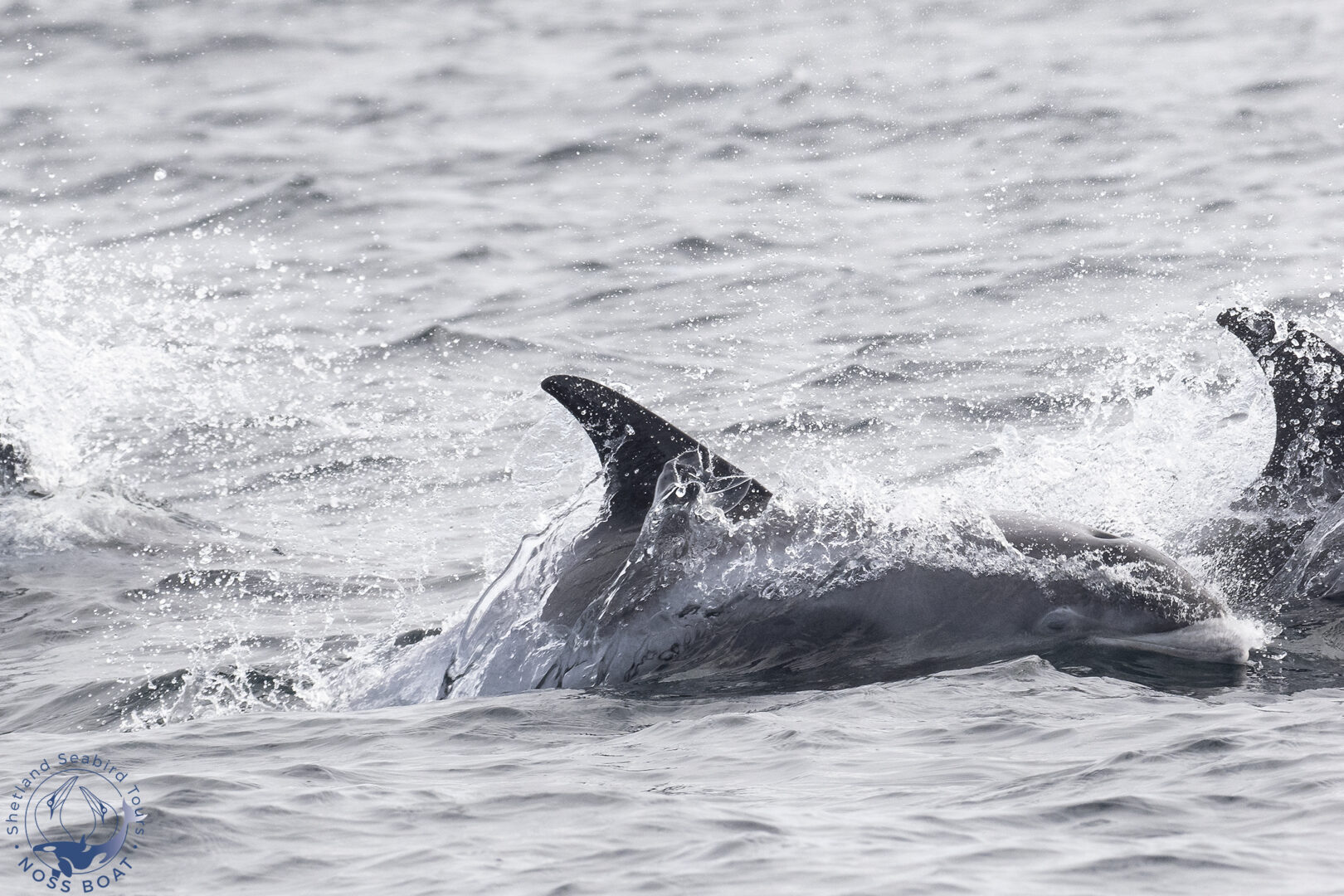
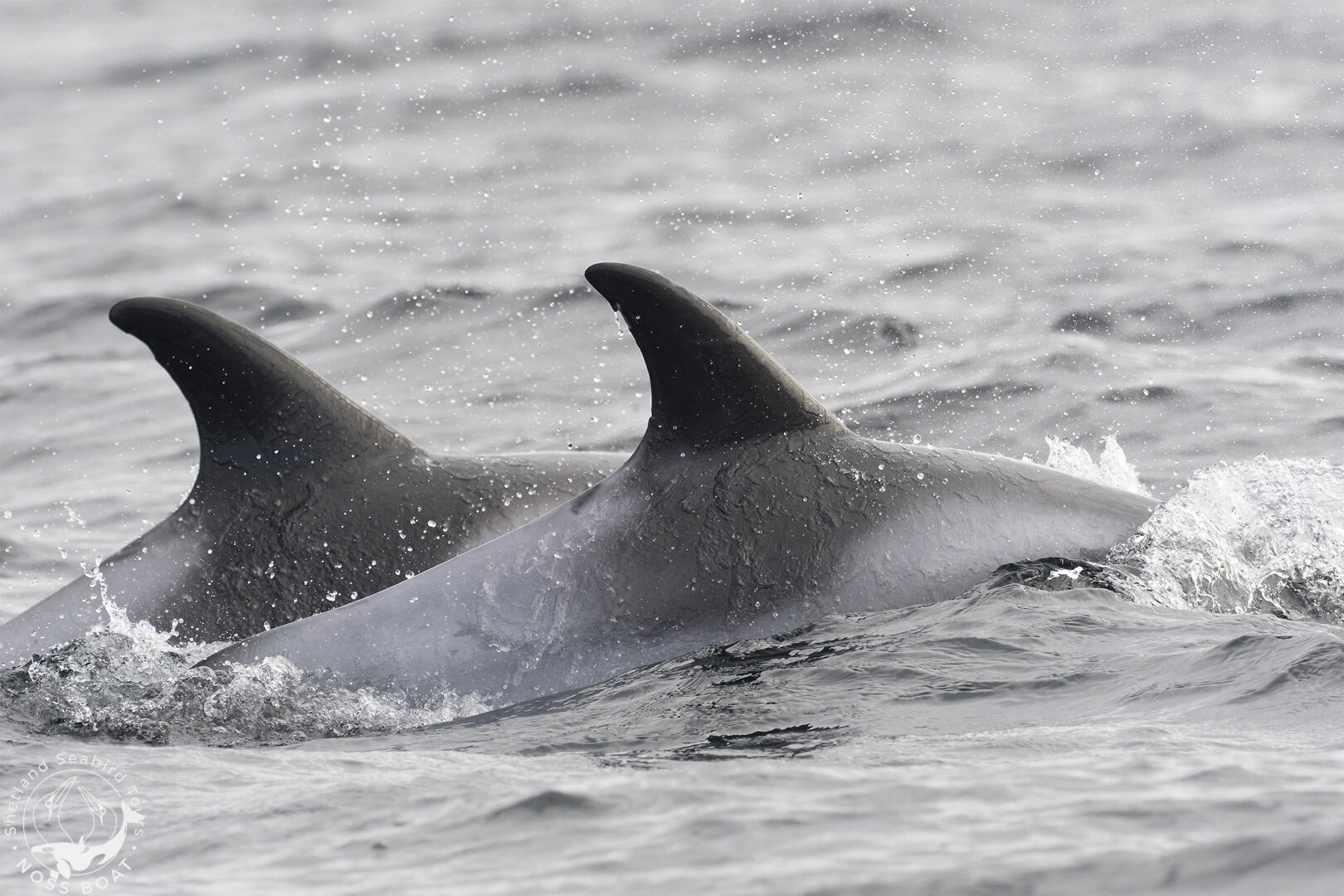
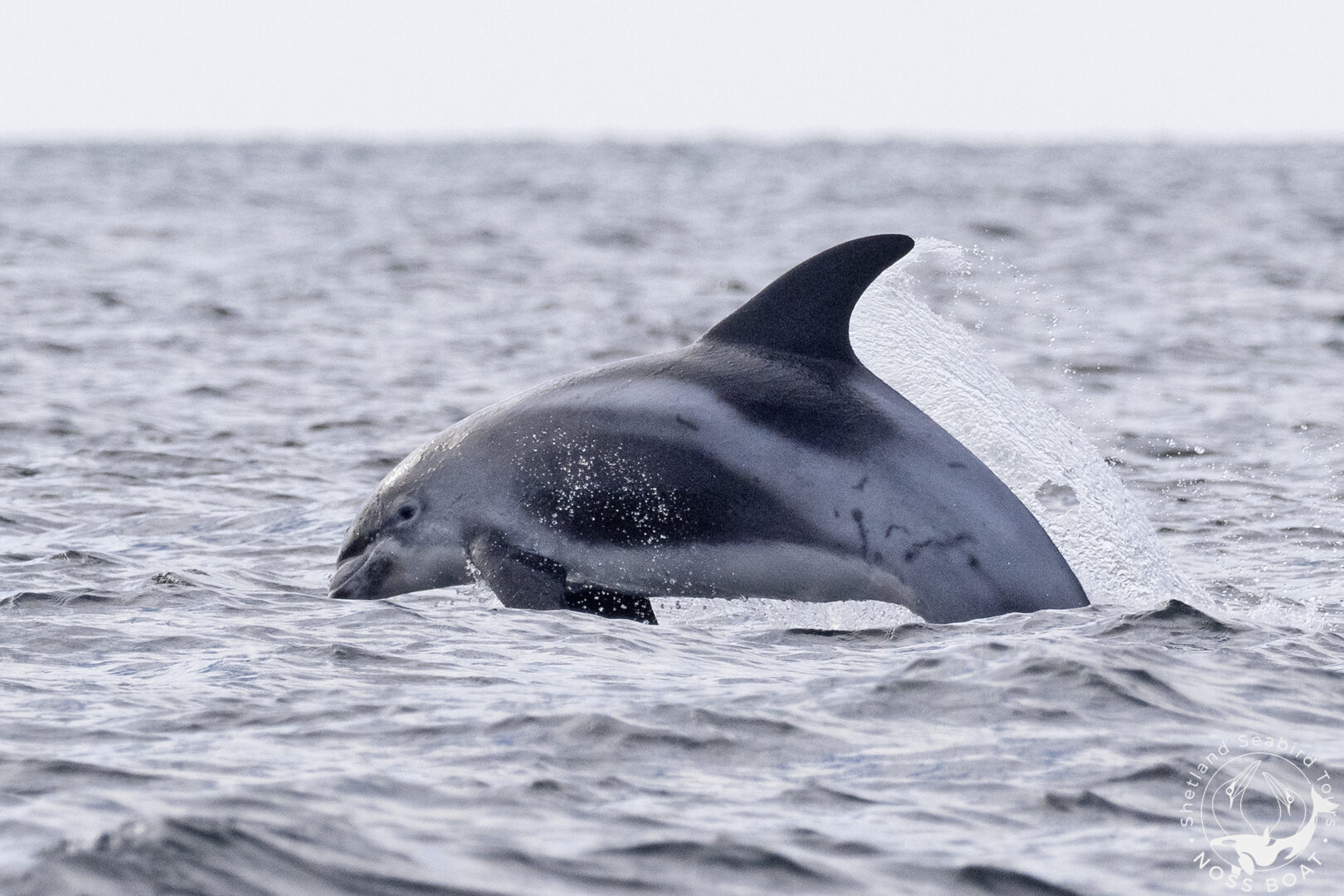
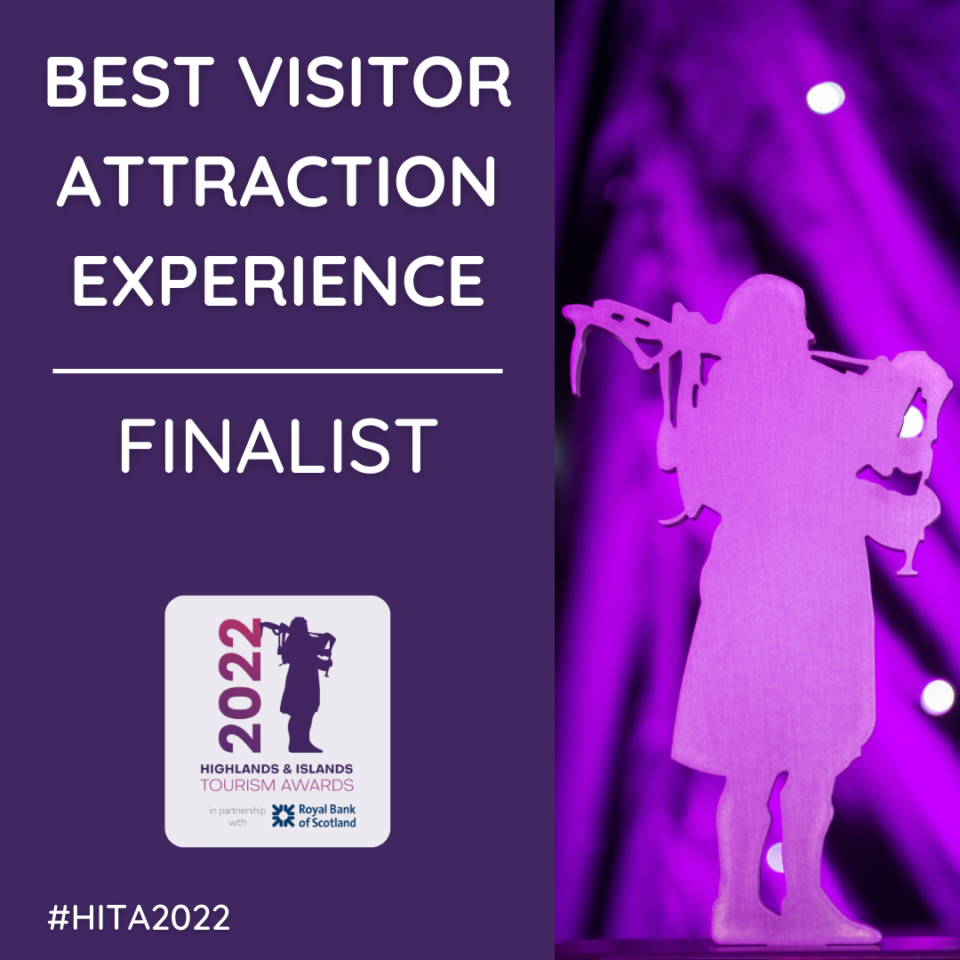
HIGHLANDS & ISLANDS TOURISM AWARDS SHORTLIST IS REVEALED!
THE shortlist for the Highlands & Islands Tourism Awards (HITA) 2022 has been announced.
The return of the Awards this year, sponsored by Royal Bank of Scotland, saw a record number of entries.
BEST VISITOR ATTRACTION EXPERIENCE
Sponsored by Port of Cromarty Firth Authority
Highland Wildlife Park
Loch Ness by Jacobite
Shetland Seabird Tours ‒ The Noss Boat
The judging panel was delighted with the strong field of submissions, particularly after such a challenging two years for the sector.
Chair of the judging panel, Calum Ross, Loch Melfort Hotel, near Oban, said: “Not only did we have a record number of entries for the Awards’ return this year but the standard of submissions was exceptional. We had an incredibly strong field this year which is all the more remarkable given the huge challenges and disruption to our industry over the past two years.
“It is fantastic to see so much resilience and work that went into each entry and so many businesses that took the time to apply. Of course, that made our job of shortlisting the entries all the more difficult!”
HITA chairman Laurence Young added: “After two long years, it’s exciting to be able to bring the Awards back. Everyone can now look forward to a wonderful Awards night where we can celebrate the achievements of our sector and recognise the dedication, professionalism and excellence shown right across the Highlands and Islands.”
https://www.shetlandseabirdtours.com/booking/
BOOKING NOW BEING TAKEN FOR 2023
Best Days with Shetland’s Birds
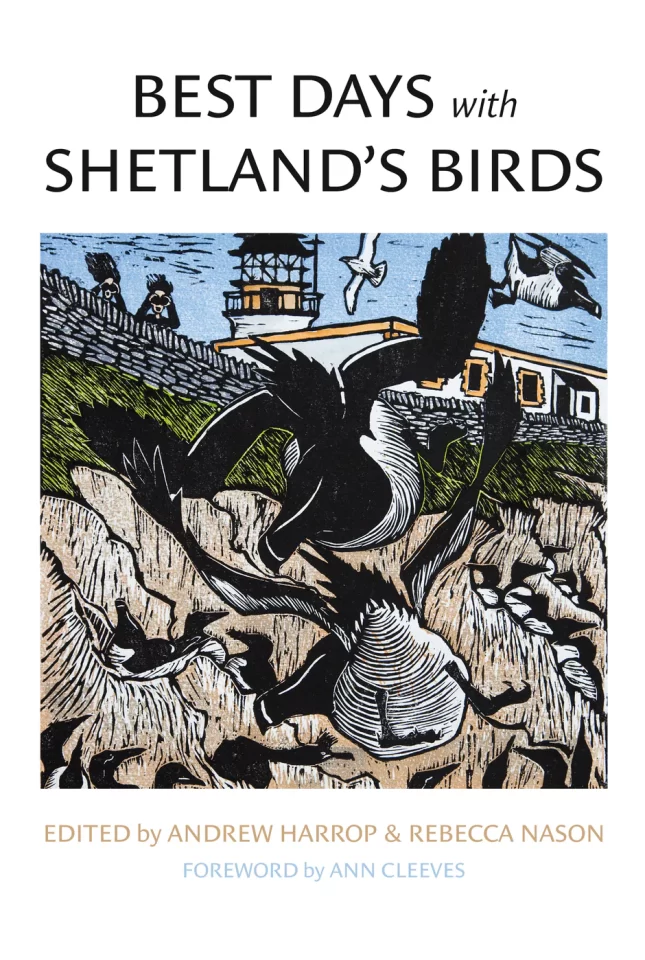 £17.99 PAPERBACK EDITION
£17.99 PAPERBACK EDITION
£26.99 HARDBACK EDITION
Spanning decades as well as the seasons, thirty well known figures of the local bird scene share what Shetland’s birds mean to them and recount their best days.
Edited by Andrew Harrop and Rebecca Nason
“I love the format of this book because it shares those moments of passion and excitement. This is no dry examination of facts or statistics. It helps us to understand the joy to be found in the natural world. These are the stories told and retold, while sheltering inside during westerly gales and horizontal rain. They’re much more interesting than bird name scrabble!
Fair Isle, and later the rest of Shetland, taught me that nature is an intrinsic part of landscape. To fall in love with a place, without an understanding of the wildlife inhabiting or visiting it, is a limited kind of affection. The accounts of very special birding days give us a real and wider sense of these beautiful islands.” Ann Cleeves
134 pages 240 x 165m. High Quality Colour Photographic illustrations & Artwork
We have been delighted with the response to our new book which was launched this Spring. There reviews & sales have been excellent & we are thrilled to have accomplished such a Shetland birding community orientated publication giving special, personal insights into birding experiences whilst living on the Isles over the years, from delighting in common birds to the rarer, there is something for everyone in this bird lovers collection…….
Thank you to co-editor Andrew Harrop for inviting me to work with him on this, and to The Shetland Times for publishing it. Thanks also to our friend Ann Cleeves for her foreword & both Howard Towll & Paul Bloomer for their art work contributions……just beautiful! We are delighted to see SHETLAND SEABIRD TOURS – THE NOSS BOAT mentioned in several accounts as well as being illustrated within, and a super account by co-owner, ornithologist & skipper Phil Harris. Both of us love being part of the Shetland birding community and this was a fun, unique way of engaging both with many contributing Shetland birding friends and promoting our birding tales and experiences to a wider audience outside of Shetland.

https://britishbirds.co.uk/content/best-days-shetland’s-birds
Here is an extract from the latest British Birds journal with a thorough review by Andy Stoddart:
“Working with a large number of contributors can be like herding cats but the editors have done a splendid job of regularising the English and producing an internally consistent set of texts. Editorial comments follow some of the accounts to add additional content and/or useful context. The editors seem to have successfully navigated the mires of birdwatching politics and produced something with a genuine community feel. Indeed, there is a very welcome effort to ensure a diversity of contributions and perspectives, such as those of the recently founded Shetland LadyBirders.
The layout is pleasing, with some fine photographs and artwork, mostly by the contributors themselves, and there are some truly iconic images, from a 1967 Dennis Coutts’ Fetlar Snowy Owl Bubo scandiacus to Rebecca Nason’s 2004 Fair Isle Rufous-tailed Robin Larvivora sibilans. The cover is a delightful and playful print by Howard Towll of auks hanging in the wind below Sumburgh lighthouse (and did I notice a Brünnich’s Guillemot Uria lomvia hiding in plain sight?).
We are a storytelling species, and birdwatchers are no different. This book is a wonderful celebration of place and a contribution to our collective folklore. It is a highly recommended companion for a dark winter’s evening:
Andy Stoddart
We have a super little review in the July Issue of BIRDWATCH magazine too…..
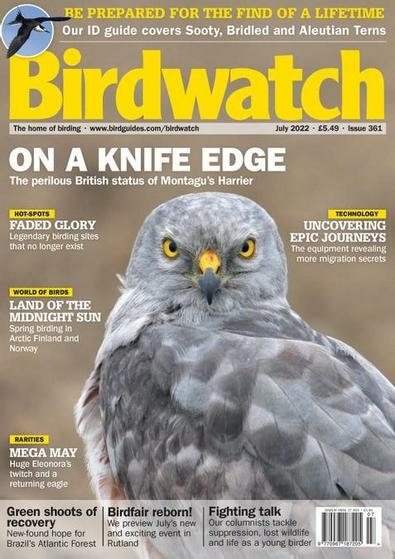
Thanks also to Shetland-based blogger Laurie & Blackpool birder Stephen for their personal reviews on their blogs………
https://natural-selection.uk/2022/06/13/review-best-days-with-shetlands-birds/
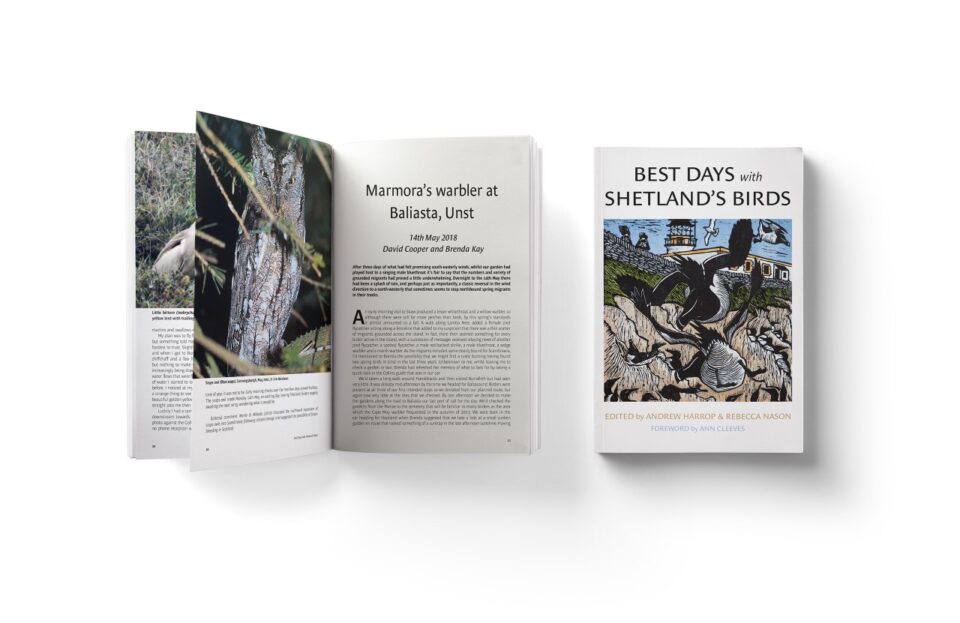
You can purchase our book from the Shetland Times who published it & were a pleasure to work with. Hardback and paperback available here via the link:
https://shop.shetlandtimes.co.uk/products/best-days-with-shetlands-birds-1

We continue to be genuinely concerned for the welfare of our seabirds here on Shetland and in many other parts of Britain, Europe, the world, in the face of the fast spreading, avian flu and the horrifically significant bird mortality rates associated with it. This is one of the most disastrous, real threats to our seabirds we have ever experienced and are ever likely to see in our lifetime. There is no easy solution to actually help the seabirds who have it, leaving many feeling utterly helpless, with no obvious answer to stopping the current trend and spread. We can only hope that the spread of the disease will plateau and the rates of infection will decrease over the breeding season, but these are factors we have no real control over. The only real solution is to hit the original source of this epidemic, a man-made disease as a result of several unacceptable factors/practices within the poultry industry. Without significant change at source, these diseases will continue to develop and leak into our already fragile, sensitive wild bird populations and spread like wildfire. This should be a significant wake up call …..
We have noticed a slight dip in adult mortality both on the cliffs of Noss and in the waters around Noss over the last few weeks. We hope that this will continue. The same cannot be said for other internationally important seabird populations, both on Hermaness, the Isle of May, Bass Rock among them. We wonder if the style of nesting which is structurally vertical and more spaced out on Noss compared to flatter, horizontal and more compact nesting colonies in some other locations may play a factor in this.
We are often being asked if our business is being affected. No it isn’t, the boat is as busy as ever, more so perhaps with the recent closure of Noss NNR by land. We continue to offer one of the most spectacular seabird wildlife spectacles in Europe and showcase what incredible marine life we have here on the islands safely by boat. Luckily so far, the mortality levels in the massive 25,000 northern gannet population at Noss still remains relatively low. We are certainly seeing less bonxies (Great Skua) than usual, though they do not breed on the cliffs so we are not witnessing the large scale destruction of this globally important seabird during our boat tours. The Great Skua population has been hit really very hard, and is very obvious on sites such as Hermaness and Fair Isle. Seabirds bring sheer joy to us and our thousands of passengers each year, we must call for urgent action and put our wild bird populations at the top of the organisations/authorities agendas.
Please note that both NOSS NNR BY LAND ONLY & THE ISLE OF MAY Reserves have now been closed to the public.
See Isle of May post here:

NatureScot’s Isle of May and Noss National Nature Reserves (NNRs) will be closed to public landings from 1 July to help protect vulnerable seabird populations from avian influenza.
Scotland’s nature agency will also be advising visitors not to take direct access onto seabird colonies on other National Nature Reserves such as Hermaness.
The measure is the latest in response to growing concern over the spread and impact of the current H5N1 strain of avian flu, particularly in seabird colonies.
The virus is widespread across Scotland, with positive cases recorded in Shetland, Orkney, St Kilda, Lewis and St Abbs. Large numbers of dead and sick seabirds have also been reported from Aberdeenshire, East Lothian and the west coast of Sutherland.
Great skua and gannets have been hardest hit. Sample surveys of colonies show a 64% decline of great skua on St Kilda and 85% at Rousay in Orkney. Great black-backed gull, Arctic tern, common guillemot and puffin have also tested positive.
The decision to restrict access to NatureScot’s two island NNRs, which in summer are home to hundreds of thousands of breeding seabirds, has been taken to limit the spread of the virus through bird populations and give colonies the best possible chance of survival and recovery by reducing any additional stress. While avian flu has been confirmed in gannets at Noss, there have been no confirmed cases on the Isle of May yet.
At other coastal NNRs such as Hermaness in Shetland, NatureScot will ask visitors not to walk through seabird colonies but to enjoy the spectacle from a distance. Local signage will be in place at those reserves affected.
Eileen Stuart, NatureScot’s Deputy Director of Nature & Climate Change, said: “The decision to close these reserves has not been taken lightly, but we are increasingly concerned about the devastating impact avian flu is having in Scotland, particularly on our seabird colonies.
“Our island reserves in particular are a haven for internationally important bird populations. The situation has been rapidly evolving and deteriorating, and we feel at this time that restricting access to these sites, and reducing it at others, is a precautionary but proportionate approach that gives us the best chance of reducing the spread of the virus and its impact.
“We recognise that this will be disappointing for those planning a visit but we hope people understand that this is about protecting our precious seabird populations for the future. Visitors will still be able to enjoy the summer seabird spectacle at both island reserves by taking round-island trips without coming ashore, and at other reserves by viewing from a short distance without crossing through colony areas. We will be keeping the situation under regular review over the coming weeks.”
NatureScot, in discussion with the British Trust for Ornithology (BTO), has already suspended ringing and research activities in seabird colonies for the remainder of the breeding season, with the exception of essential surveillance of avian flu.
Surveillance monitoring is being coordinated at key sites and NatureScot is working at speed with the Scottish Government and conservation organisations to develop an effective overall strategy. Central to NatureScot’s role is gaining a better understanding of the changing situation, to inform action to help populations recover.
The current situation follows a large outbreak in Svalbard barnacle geese last winter where H5N1 is estimated to have killed 30-40% of the wintering population.
Avian flu has been found across species with positive reports from pink-footed geese, buzzards, mute swans, a red kite and a sea eagle for example. It is unfortunately amongst breeding seabird colonies where currently the most significant and worrying mass mortality events are occurring. Read this article ion their website here:
A couple of weeks ago we were chartered to take RSPB & NatureScot out to Noss so that they could film, interview and take in first hand the effects of avian flu on the vast seabird colonies of NOSS NNR. The video contains images of dead birds. Please see one of the videos made here below:
We will continue to monitor and offer any assistance needed from the sea, and keep in contact with both the RSPB here on Shetland and NatureScot on any new developments.
RSPB SHETLAND AVIAN FLU VIDEO – WITH SHETLAND SEABIRD TOURS – THE NOSS BOAT
How damaging is bird flu to our wild birds?
Since 2006 there have been several outbreaks of avian influenza in the UK, the vast majority of which have been on domestic poultry farms. There had been very few cases of the virus being detected in wild birds in the UK. But this has recently changed with an unprecedented series of outbreaks – the largest ever in the UK.
In January 2022 there was a severe outbreak on the Solway Firth, Scotland, where more than 4,000 barnacle geese died. These birds, which migrate from Svalbard in arctic Norway, were seen falling from the sky in distress and lines of dead birds were washed up on beaches.
In June 2022 there have been reports of widespread deaths of great skuas on Shetland, Fair Isle, Orkney, the Western Isles, Handa, the Flannan Isles and St Kilda. Gannets have been hit at some of their key colonies, including Noss in Shetland, Troup Head in Northeast Scotland and Bass Rock in the Firth of Forth.
There are also reports of sandwich and Arctic terns dying as well as numbers of guillemots at a colony on the Mull of Galloway.
What does this mean for our seabirds?
Britain’s seabird populations are of global significance. For example, the UK is home to 56% of the world’s gannet population and Scotland has 60% of the world’s great skuas. These and other seabirds are already under massive pressure from climate change, lack of prey fish, deaths through entanglement in fishing gear and developments along our coasts. The impact of avian flu could hit them particularly hard as seabirds tend to live for a long time and take longer to reach breeding age. They also usually have fewer chicks. This means deaths from bird flu could further decrease declining numbers and that any recovery from the disease would take far longer.
What should UK governments be doing?
The bird flu which is causing these birds to die is a highly mutable and deadly new form which originated in poultry farming.
The RSPB are calling on UK governments to develop a response plan urgently. We want to see coordinated surveillance and testing, disturbance minimisation, carcass disposal and biosecurity to stop the spread.
In the longer term, we want much higher importance being given to prioritising and funding seabird conservation. This would help make our seabird populations more resilient to these diseases and the other challenges they face.
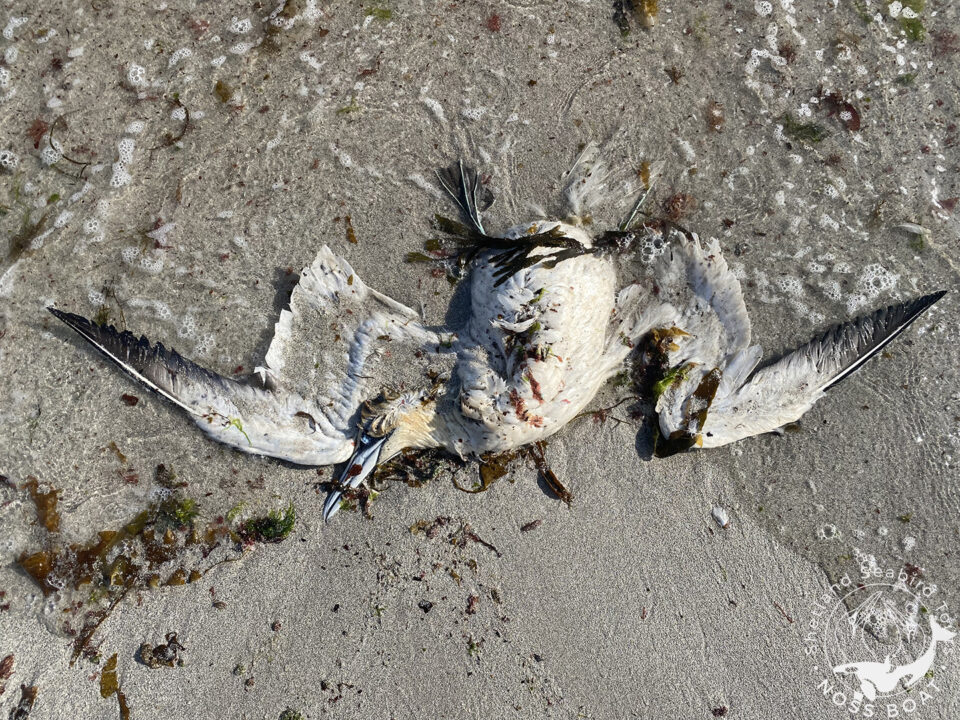
Check out this worrying development, with Mark Avery reporting on avian flu working its way through the Roseate Terns at Coquet Island….posted today 1st July 2022.
Concern is mounting for seabirds on RSPB Coquet Island in Northumberland, the UK’s only roseate tern breeding colony, and across the UK, following confirmed cases of Avian Influenza.
https://markavery.info/2022/07/01/rspb-press-release-roseate-terns-and-avian-poultry-flu/
Another article today from a different perspective…interesting figures and suggestions for reducing the mortality costs within the poultry industry.
Our friends in the Netherlands are faring no better…..see here the obliteration of a Sandwich Tern colony this spring, just one example of the devastating impact this epidemic is having over there…….
https://www.dutchnews.nl/news/2022/06/largest-sandwich-tern-colony-on-texel-wiped-out-by-bird-flu/
This post is correct to the best of our knowledge, please do get in touch with us if you would like to point us to further details or highlight any areas missed ……
Rebecca Nason 1st July 2022
Shetland Seabird Tours – The Noss Boat, are delighted to see the photographic side of our business really take-off over the last few years alongside our regular, popular scheduled tours. Since we started our boat tours back in 2016, we have collaborated & enjoyed working with some amazing names in the photographic and film industry, honing our skills to be able to offer a professional, knowledgeable boat platform to help others achieve outstanding results. In the 2nd of our showcase posts, we celebrate the wonderful work of Professional Wildlife Photographer, Natural History Author & Tour Leader Andy Howard. Check out his amazing portfolio of images on his website: www.andyhoward.co.uk




Andy has been coming to Shetland leading wildlife & photography tours for many years & has been collaborating with us to offer his clients bespoke photo tours to Noss throughout . We were already well aware of Andy & his wonderful photography before we met him, it has been wonderful to help provide a stable, comfortable boat platform to create super imagery from, for part of his bespoke Shetland photographic group experiences. We are enjoying our Early Bird Boat Tours with Andy & guests this week & look forward to seeing more of his Shetland imagery soon. Andy has written 3 highly acclaimed books (shown above), the latest being his Otter book The Secret Life of the Otter published in 2021. Andy is well known for his extraordinary images of Mountain Hare & Red Squirrel, many of which can be seen in his other publications in the same series, The Secret Life of the Mountain Hare (2018) & The Secret Life of the Cairngorms (2019).
Andy says ….
“We fell for the charms of Shetland and its friendly and welcoming people a decade ago and have made return visits every year since. Each and every time have returned from our travels with stories to tell and memory cards full of images. It’s without a shadow of a doubt my second favourite destination to photograph wildlife, outwith my beloved Cairngorms”.
Extract from Andy’s Bio on his website:
“A major part of my life as a professional entails running workshops, masterclasses and photo-tours. I love doing this and relish the opportunity to improve and encourage my guests/clients to improve their photography skills whilst at the same time capturing images they can be proud of. Many of my guests/clients have gone on to win competitions with images taken whilst out with me including a category win in the BWPAs!”.
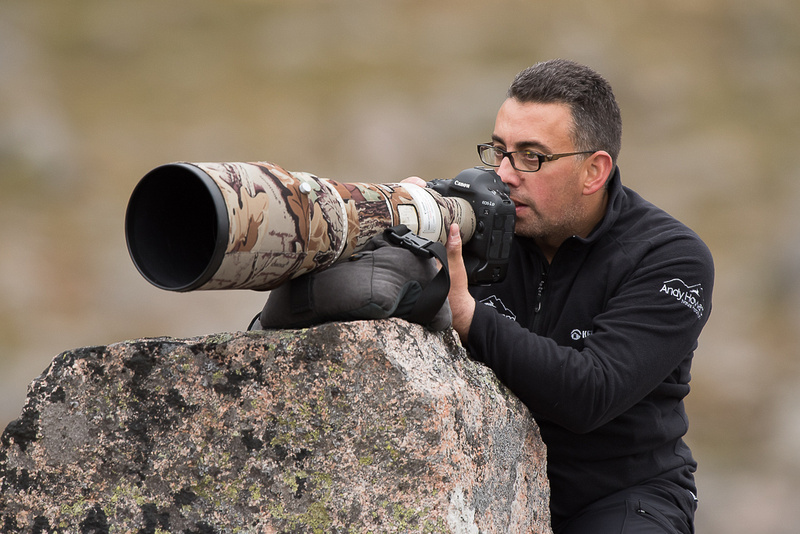
Check out Andy’s Social Media Pages:
Facebook page: www.facebook.com/Andy-Howard-Nature-Photography
And Instagram: www.instagram.com/hare_whisperer
And Twitter: twitter.com/highland_andy
Many of you will have become aware of the devastating impact that Avian Flu is having on wild birds, in particular seabirds now, as well as the poultry industry, this spring. Here on Shetland, the disease is spreading most notably among the Northern Gannet & Great Skua populations on the Islands. We have witnessed at first hand the devastating consequences of this disease working through the Noss NNR gannet colony, as this site is a daily fixture on our Noss Boat wildlife tours. Home to over 25,000 northern gannets & thousands of other seabirds during the summer months, Noss cliffs by boat, is hailed as one of Europe’s finest wildlife spectacles, & one we have had pleasure in sharing with thousands of passengers over the years and continue to do so. There are many threats facing our seabirds, many of the current issues are shared as part of our daily live commentary as well as touching on the state & future of the health of the wider marine environment. But to see this new disease at work, killing hundreds of what has been one of our most resilient, successful seabirds, the northern gannet, is very upsetting for all to witness & with no obvious help or solution at hand, we watch with a strong sense of helplessness. All we can do for now is to monitor & hope that this disease will depart as quickly as it arrived, only time will tell. We have liaised & collected samples for NatureScot to initially confirm the disease among Noss gannets, we will continue to offer support where we can.
Hermaness NNR on Unst, also home to a similar number of northern gannets is equally affected, as are apparently, smaller gannet colonies on Foula & Fair Isle. Scotland holds over 40% of the world’s total population of northern gannets, around 180,000 pairs over 14 colonies. Not all colonies have confirmed cases of avian flu at the current time. Icelandic populations have recently confirmed avian flu within their breeding populations, meaning the majority of the endemic northern gannet populations in Europe are now at serious risk of significant losses after years of slow but steady growth.
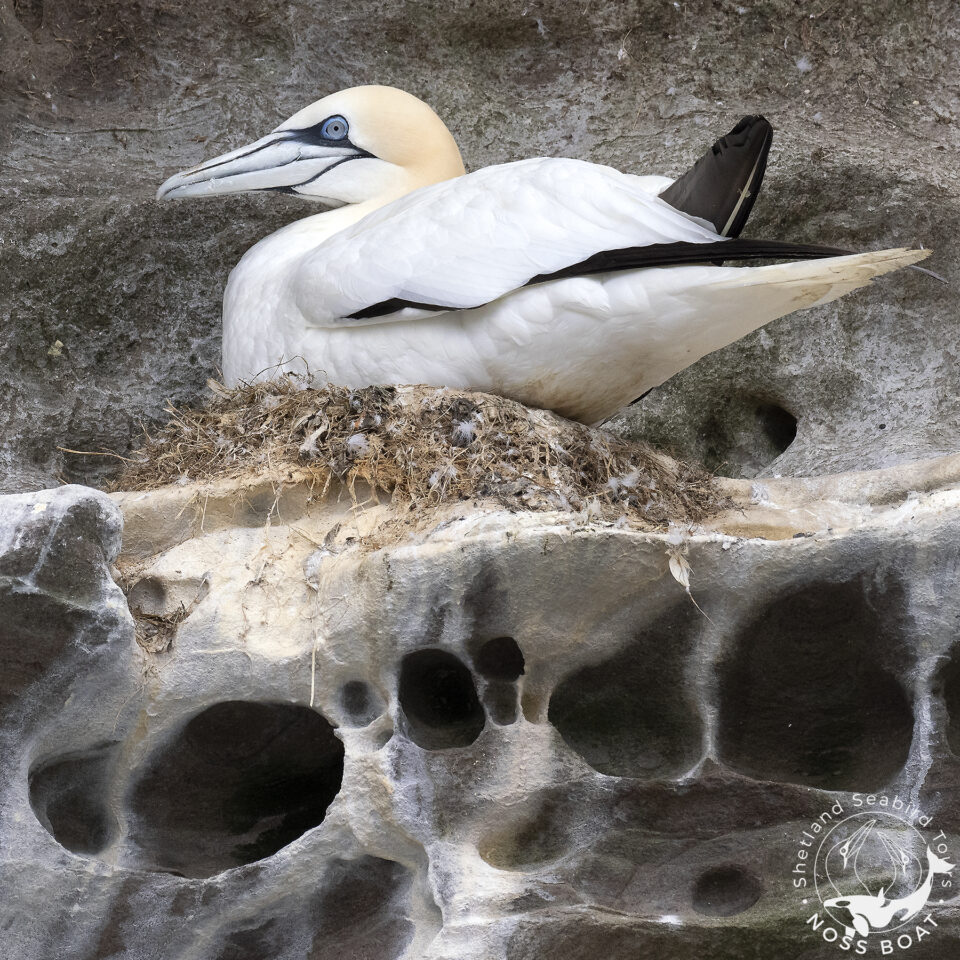
RSPB LATEST STATEMENT:
“The 2021/22 outbreak of HPAI is still affecting wild bird populations in the UK. This has been the worst ever outbreak of HPAI in the UK and has not only affected a large number of birds but is ongoing over a long time period. You can see previous blogs for more information and the story of the unprecedented impact this strain of HPAI has had, causing the loss of a third of the Solway barnacle geese population. We have been in unchartered territory with the disease this year and its effects on wild birds. This is continuing with the focus now being on seabirds in Scotland.
Late last summer, sick and dead great skuas were found in Shetland, Orkney, St Kilda and the Flannan Isles and they tested positive for HPAI. This happened just prior to migration – the species winters off North and West Africa – so the scale of impact on the population was unclear. Now the skuas are back and RSPB Scotland is collating data from colonies to assess impacts, but we were not expected to find great skuas again sick and dying from HPAI. We are also seeing eider ducks and other seabirds including gannets succumbing to HPAI.
Britain’s seabird populations are of global significance with the UK holding 56% of the worlds northern gannet population and Scotland holding 46% of the world’s northern gannets and 60% of the world’s great skuas. Both these species are amber listed in Birds of Conservation Concern 5. Our seabirds are already under massive pressure from human impacts including climate change, lack of prey fish, deaths through entanglement in fishing gear and development pressure. There is great concern for the potential impacts of HPAI on our already beleaguered wild birds.
The RSPB believes that to deal with future HPAI outbreaks in wild birds, improved surveillance, testing and carcass collecting is essential and that an effective plan should be put in place for biosecurity measures and disturbance minimisation to alleviate the pressures on these birds. But this is only the surface of the problem, we must take actions towards effective conservation of our wild bird species“. – Nick Hawkes June 1st 2022
Scotland: https://www.gov.scot/publications/avian-influenza-bird-flu/
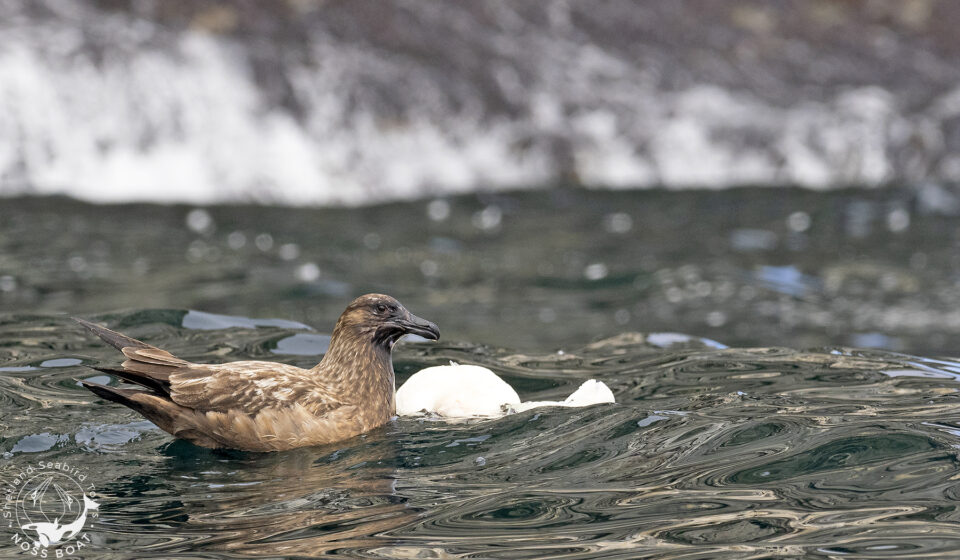
“Birds can be infected with the avian influenza virus through contact with infected individual birds or waste products. Wild birds including waterfowl can carry and transmit the virus without showing evidence of disease. Movements of poultry around and between countries, and the migrations of wild birds, are both known vectors of the virus.
Although the risk of contracting the disease from a wild bird is very low, we recommend that people do not handle sick or dead wild birds, remain vigilant, and report dead wild waterfowl (swans, geese or ducks), seabirds or birds of prey to the DEFRA helpline (03459 33 55 77). See DEFRA’s website here for more details” – Nick Hawkes June 2022
https://www.gov.uk/guidance/avian-influenza-bird-flu
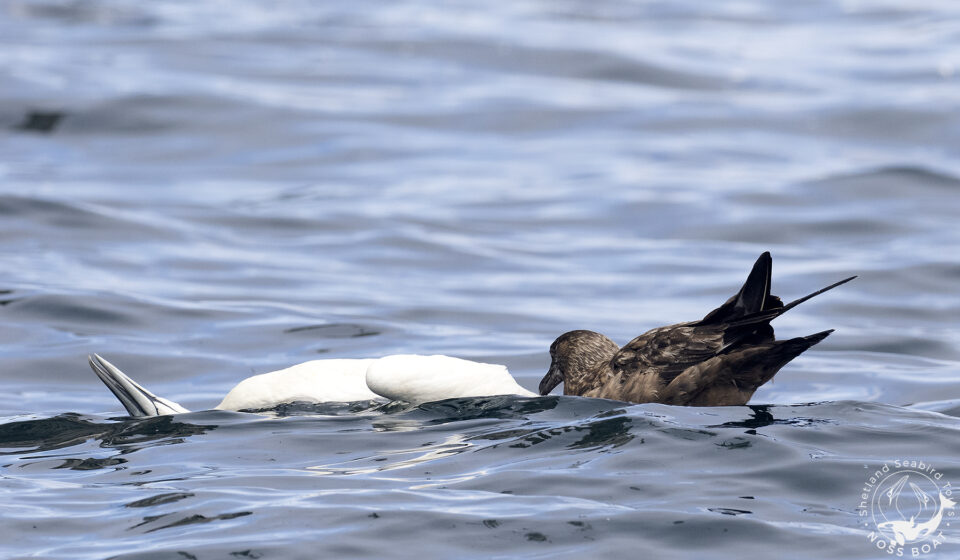
Great Skuas or “bonxies” as they are known in Shetland, one of our most iconic seabirds, were first confirmed with avian flu last year & this year has seen a frightening development in the numbers of affected birds & mortality levels across Shetland this year. Shetland & Orkney hold over 60% of the world population of Great Skua, and 90% of the UK breeding population. They have a very restricted breeding range confined to the northeast Atlantic and migrated to spend the winter in north-west Africa. We have seen many dead bonxies in the water around Noss as well as alive birds clearly showing signs of the disease. We have been bonxies feeding on the infected corpses of northern gannets and of course chasing other seabirds for food, all have a high risk of cross-infection between species. There have been devastating scenes of dead & dying bonxies on Noss & Hermaness in recent weeks. Again at this stage, all we can do is to monitor & wait for any new government guidelines or initiatives but it is expected that Bonxies will have a disastrous breeding season this year with high mortality rates & low productivity. What we can do, as the RSPB & NatureScot have stated, is to call for urgent adoption of policies & conservation action to help maximise the resilience of our seabird populations, which are under enormous threats from climate change, bycatch mortality, the impact of non-native predators & disease outbreaks such as avian flu.
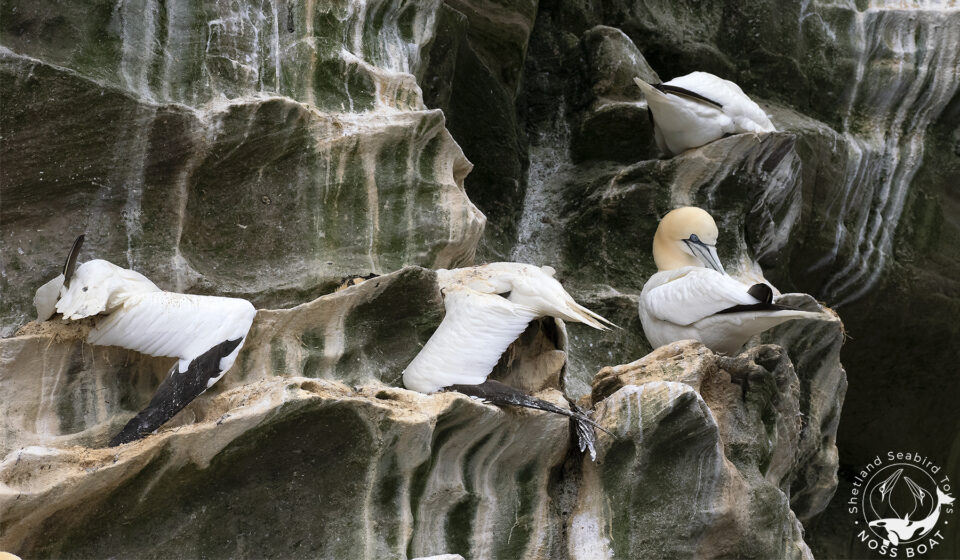
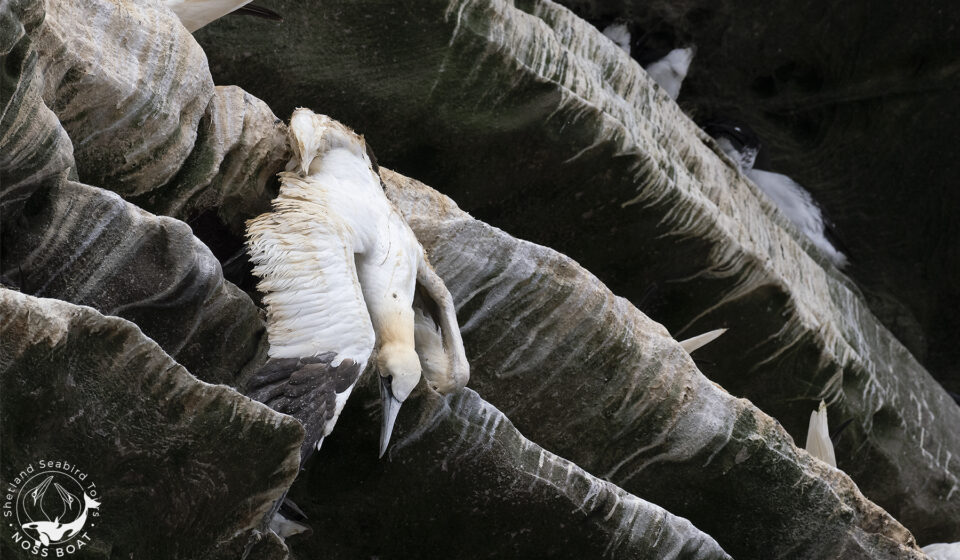
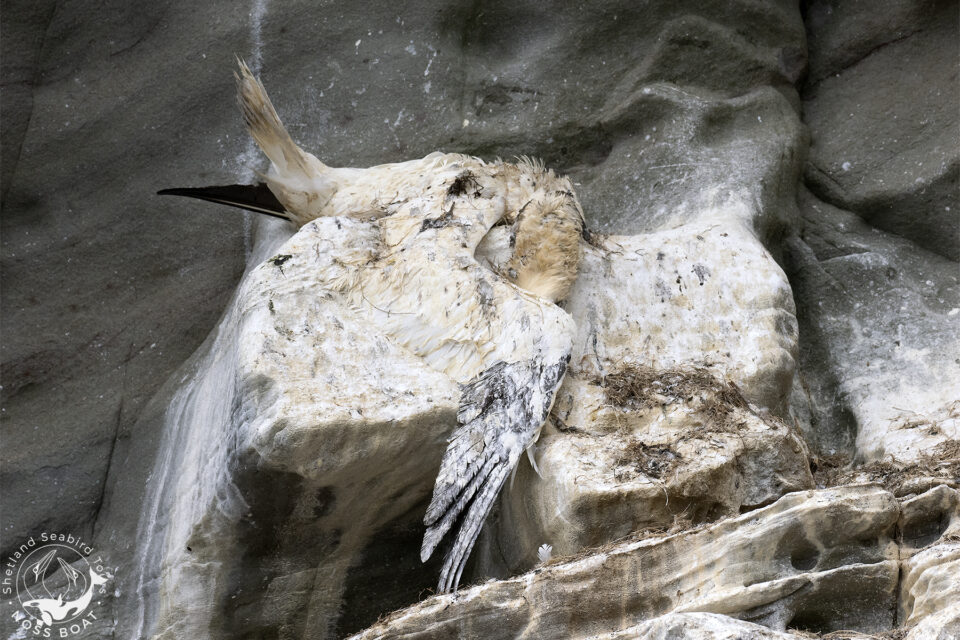
Shetland Seabird Tours – The Noss Boat, are delighted to see the photographic side of our business develop so well over the last few years alongside our regular, popular scheduled tours. Since we started our boat tours back in 2016, we have collaborated & enjoyed working with some amazing names in the photographic and film industry, honing out skills to be able to offer a professional, knowledgeable boat platform to help others achieve outstanding results. We have regularly collaborated with the incredible underwater photographer, ecologist and Shetland resident Richard Shucksmith who has brought some outstanding photographers aboard bespoke workshops and tours all catering for different styles and requirements from amateur to professional. In our first of many showcase posts, our first highlights the latest photographic successes of the awesome Henley Spiers, who we welcomed aboard last year for the first time and who will be joining us again in 2022. Henley recently won 1st and 3rd places in the UPY 2021 British Waters Wide Angle category, see below. Henley has also written a fabulous illustrated article on his Shetland experiences last year in this months COAST magazine.
Gannet Success:
With the @upycontest results just released and now whizzing their way across news outlets worldwide (no joke), I’m glad to report that a couple of my frames made the final collection. Not having left British waters in 2021, it’s great to see a couple of my favourite marine moments appreciated by the judges, picking up 1st and 3rd place in the British Waters Wide Angle category.
The category winner is entitled ‘Gannet Storm’ and as an extra bonus it’s also the cover shot for the UPY 2022 Yearbook:
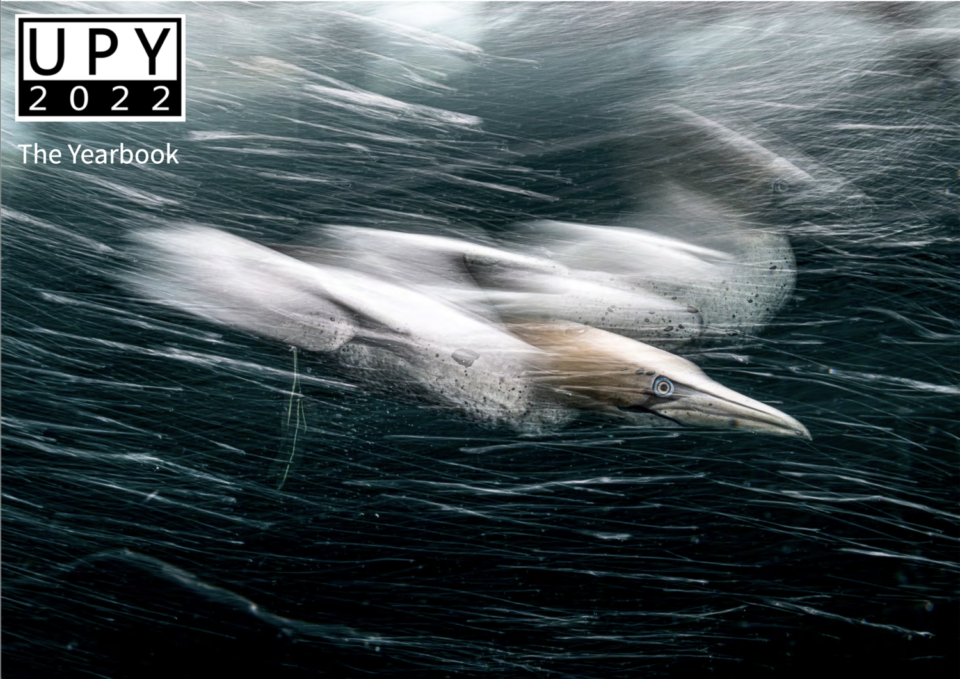
“A northern gannet swims in an artistic hail of bubbles created by diving seabirds. 40,000 gannets visit the nearby cliffs annually to lay and care for a single egg, fishing for food nearby. Hitting the frigid water faster than an Olympic diver, these incredible birds have evolved airsacs in the head and chest to survive these repeated heavy impacts. From underwater, the sound was thunderous as streamlined, white torpedos pierced the surface. I wanted to create a novel image of these handsome seabirds and resolved to try and capture their movement through a slow exposure. The speed of the gannets led to innumerable failures but in this frame we retain strong eye contact with the gannet, even as the scene is artistically softened. With great thanks to @richardshucksmith , without whom this encounter with the gannets would not have been possible.”
Here’s what judge @alexmustard1 says: “That eye and this moment. A powerful picture. Diving gannets have won this category before, but we’ve never had a portrait like this, that reveals both the personality of this predator and the energy of the action.”
You can read all about Henley’s successful trip to Shetland in 2021 in this months COAST magazine!
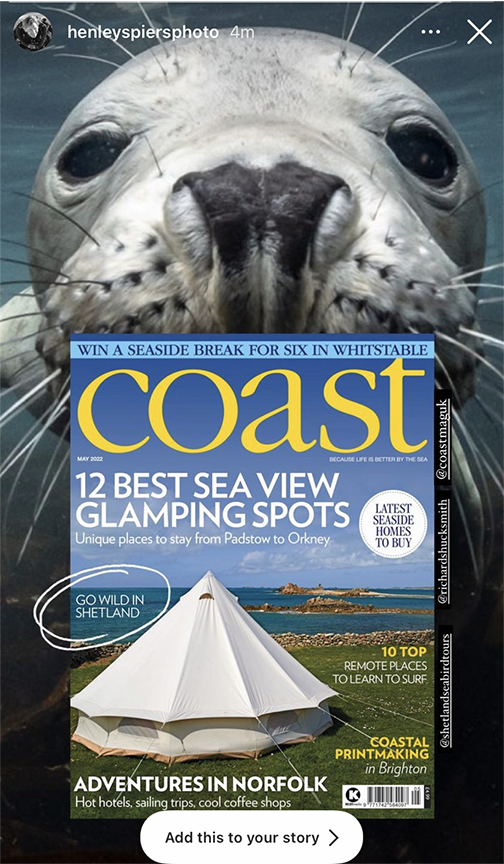
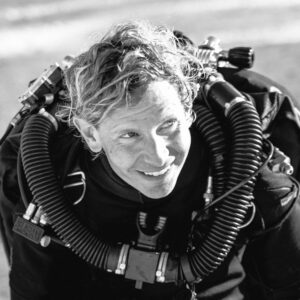 ABOUT
ABOUT
Henley Spiers, half British and half French, is a renowned photographer, writer, and trip leader who has fast become one of the most highly decorated underwater shooters in the world.
Starting his professional career in diving as an instructor, working in the Philippines, Indonesia and Saint Lucia, he later fell in love with underwater imagery and made the transition to full-time photographer.
Since then, Henley has amassed a prolific series of award-winning images, including two category wins in the Underwater Photographer of the Year, winning first prize in the Black & White category of Nature Photographer of the Year, and winner of the Ocean Geographic David Doubilet portfolio award.
Henley’s photography has been published in the likes of The Sunday Times, Der Spiegel, and Sierra Magazine, and frequently graces magazine covers.
As an accomplished (and bilingual) writer, Henley’s words often accompany his images, and he is a regular contributor to DIVER magazine (UK), EZ Dive magazine (Taiwan), Plongez magazine (France), and Hakai magazine (Canada). Readers enjoy Henley’s conversational writing style, delivering insight without pretension and usually with a touch of humour. Notably, he has also written for Asian Diver, Outdoor Photography Magazine, bioGraphic, and Black + White Photography magazine.
In 2019, Henley co-authored Black is the New Blue Vol. II, showcasing blackwater diving. His latest book, the Guide to Cebu, co-written with wife and frequent collaborator, Jade, showcases the very best of diving in their former home. Available in the Philippines, the international launch for Guide to Cebu has been delayed due to the current pandemic.
Henley also leads trips to see incredible underwater wildlife encounters, specialising in small-group adventures to rarely seen locations and events. Sought-after as a teacher, Henley’s coaching on these trips has seen a number of attendees go on to become award-winning photographers in their own right.
Although he would be the first to admit that he can still do more to help, Henley has so far enjoyed collaborating in the field of ocean conservation with Blue Marine, Mission Blue, Bertarelli Foundation, Marine Conservation Society, Devon Wildlife Trust, Cornwall Wildlife trust, and Thunnus UK.
In 2019, Henley was honoured to be invited by Blancpain to the Edition Fifty Fathoms Ocean Commitment programme, joining a select group of the world’s foremost underwater photographers.
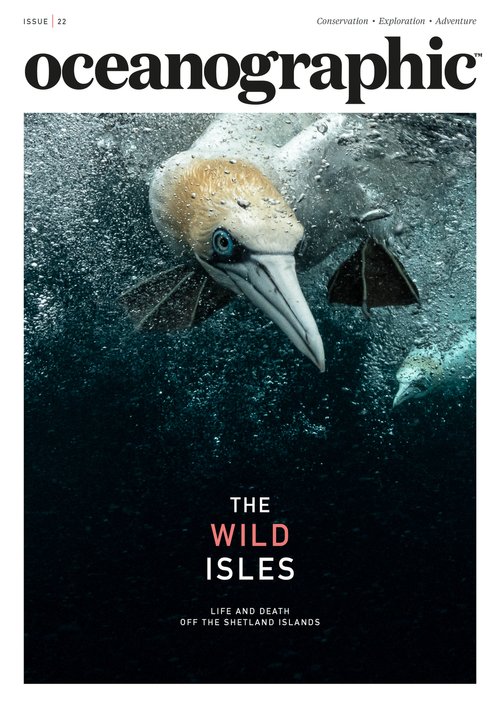
Shetland Seabird Tours – The Noss Boat gains professional WiSe Award Accreditation – March 2022. We are leading the way as a major boat-based tourist attraction in Shetland, on how to behave & operate responsibly & safely around the marine wildlife rich environment here on Shetland. We are delighted to be the first to have this accreditation for the start of the 2022 season, having been aware of WiSe for many years. Its main aim of minimising disturbance to marine wildlife is also fundamental to our own company ethos and branding, having two professional ecologists at its core.
“All commercial operators trained and accredited under the WiSe Scheme have an opportunity to lead the public, through demonstrating the example of best practice in the field and ensuring that all commercial operations are sustainable. In doing so you will be helping the long-term future of our precious marine life, for the benefit of future generations”.
The UK’s national training scheme for minimising disturbance to marine wildlife
The waters around the UK are home to a fantastic variety of marine wildlife, whether visible from the shore or from a boat. However, these wild animals are vulnerable to disturbance if not encountered in a manner that respects their wild nature.
The WiSe Scheme is about watching marine wildlife the wildlife-safe way.
Our aim is to promote responsible wildlife-watching, through training, accreditation and raising awareness. The WiSe Scheme is a simple modular training course aimed primarily at wildlife cruise operators, dive and service boats, yacht skippers and sea kayakers, plus people participating in coasteering, stand-up paddle boarding and wild swimming. These groups of people are most likely to come into contact with marine wildlife, as they are likely out on the water on a regular basis. We also seek to educate the general public who are keen to minimise their impact whilst out on or near the water.
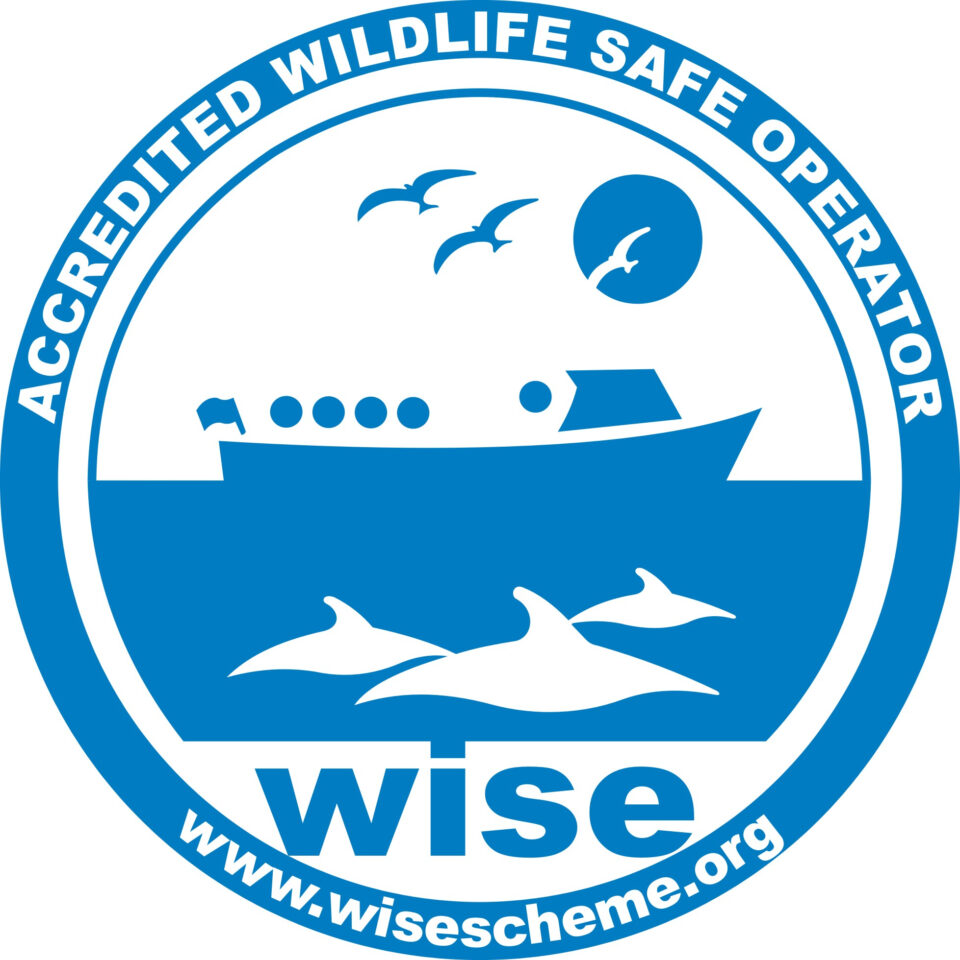
“We enhance people’s understanding on how to avoid disturbing wildlife”…….
We are delighted to have our new Noss Boat Gift Vouchers now ready for the 2022 season. Do get in touch with us to purchase yours today and treat someone special with a fabulous wildlife-filled boat experience during their Shetland holiday…..
